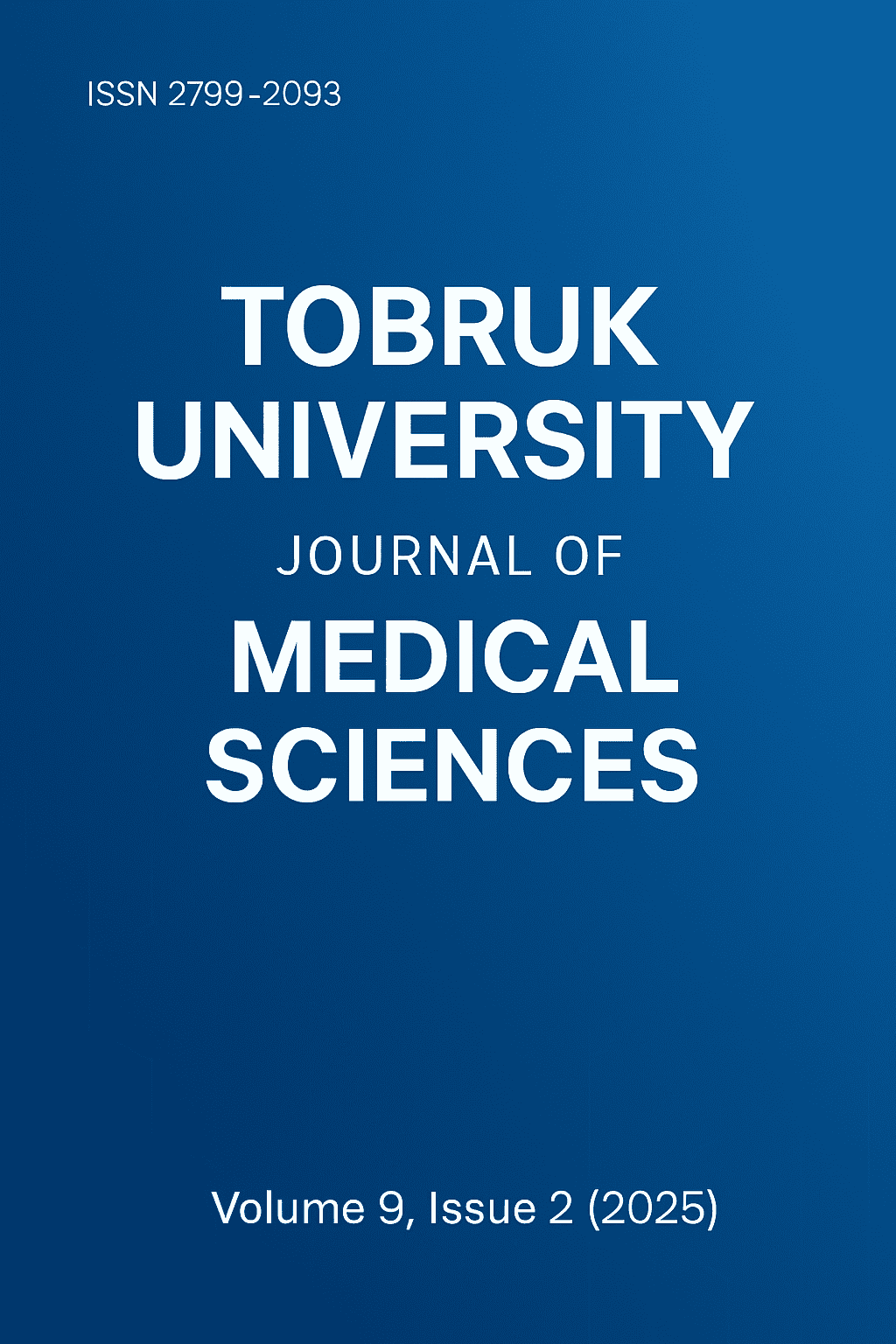Incidental Prostate Cancer Despite Normal PSA and DRE: Evidence from a Libyan TURP Cohort
DOI:
https://doi.org/10.64516/tujms.v9i2.01Keywords:
Incidental prostate cancer , Trans urethral resection of the prostate , Benign prostatic hyperplasiaAbstract
Background: Incidental prostate cancer (IPC) is occasionally diagnosed following transurethral resection of the prostate (TURP) performed for benign prostatic hyperplasia (BPH). Although men with normal preoperative prostate-specific antigen (PSA ≤ 4 ng/mL) levels and unremarkable digital rectal examination (DRE) findings are typically considered low-risk, the true incidence of IPC in this subgroup remains inadequately characterised. This raises concerns about the reliability of PSA and DRE as sole screening tools. Objectives: The primary objective of this study was to determine the incidence of IPC among patients undergoing TURP at a single centre in Tobruk, with normal preoperative PSA and DRE results. A secondary objective was to explore potential associations between IPC detection and patient characteristics, including age and PSA levels. Methods: A retrospective analysis was conducted on 81 patients who underwent TURP for symptomatic BPH at Tobruk Medical Center between January 2022 and January 2024. All patients had normal preoperative PSA levels (≤ 4 ng/mL), normal DRE findings, and no prior clinical suspicion or diagnosis of prostate cancer. TURP specimens were routinely subjected to histopathological examination to identify IPC. Statistical analyses were performed to assess differences between IPC-positive and IPC-negative groups. Results: IPC was identified in 7 of 81 patients, corresponding to an incidence of 8.6% (95% confidence interval: 3.6%–17.2%). Patients with IPC tended to be older and exhibited slightly higher PSA levels compared to those without IPC; however, these differences did not reach statistical significance. The limited number of IPC cases constrained the statistical power of the analysis, warranting cautious interpretation. Conclusion: An IPC incidence of 8.6% was observed among patients with normal preoperative PSA and DRE findings undergoing TURP. These findings underscore the potential limitations of relying solely on standard screening methods and highlight the value of routine histopathological evaluation of TURP specimens, even in presumed low-risk populations.
References
1. Sung H, Ferlay J, Siegel RL, Laversanne M, Soerjomataram I, Jemal A, Bray F. Global cancer statistics 2020: GLOBOCAN estimates of incidence and mortality worldwide for 36 cancers in 185 countries. CA Cancer J Clin. 2021;71(3):209–49.
2. Fowler JE Jr, Pandey P, Bigler SA, Yee DT, Kolski JM. Trends in diagnosis of stage T1a-b prostate cancer. J Urol. 1997;158(5):1849–52.
3. Epstein JI, Allsbrook WC Jr, Amin MB, Egevad LL; ISUP Grading Committee. The 2005 International Society of Urological Pathology (ISUP) Consensus Conference on Gleason grading of prostatic carcinoma. Am J Surg Pathol. 2005;29(9):1228–42.
4. Tombal B, Visccher D, Cosyns JP, Lorge F, Opsomer R, Wese JF, Van Cangh PJ. Assessing the risk of unsuspected prostate
cancer in patients with benign prostatic hypertrophy: a 13-year retrospective study of the incidence and natural history of T1a–T1b prostate cancers. BJU Int. 1999;84(9):1015–20.
5. Jones JS, Follis HW, Johnson JR. Probability of finding T1a and T1b (incidental) prostate cancer during TURP has decreased in the PSA era. Prostate Cancer Prostatic Dis. 2009;12(1):57–60.
6. Capogrosso P, Ventimiglia E, Scattoni V, Montorsi F, Salonia A. Incidental prostate cancer after transurethral resection of the prostate: a 10-year single-centre experience. Urol Oncol. 2016;34(4):181.e9–181.e14.
7. Cheng BK, Li CY, Lin CJ, et al. Predictors of incidental prostate cancer following endoscopic enucleation of the prostate: a systematic review and meta-analysis. World J Urol. 2022;40(1):87–101.
8. Augustin H, Erbersdobler A, Graefen M, Fernandez S, Palisaar J, Huland H, Hammerer P. Biochemical recurrence following radical prostatectomy: a comparison between prostate cancers located in different anatomical zones. Prostate. 2003;55(1):48–54.
9. Rajab R, Fisher G, Kattan MW, Foster CS, Møller H, Oliver T, et al. An improved prognostic model for stage T1a and T1b prostate cancer by assessments of cancer extent. Mod Pathol. 2011;24(1):58–63.
10. Capitanio U, Scattoni V, Freschi M, Briganti A, Salonia A, Gallina A, et al. Radical prostatectomy for incidental (stage T1a–T1b) prostate cancer: analysis of predictors for residual disease and biochemical recurrence. Eur Urol. 2008;54(1):118–25.
11. Biers SM, Oliver HC, King AJ, Adamson AS. Does laser ablation prostatectomy lead to
oncological compromise? BJU Int. 2009;103(4):454–7.
12. al-Abrash HM, El-Mehdawi RR, Saleh MI, Elhadi M. Cancer incidence in southern Libya: Updated hospital-based registry from 2016 to 2018. Afr J Urol. 2021;27:33.
13. El Mistiri M, Basheer M, El Sahli N, Shembesh NM, Attia Z. Cancer incidence in Eastern Libya: a population-based analysis. East Mediterr Health J. 2010;16(7):710–5.
14. Zidan A, Elhadi M, Elhadi A, et al. Epidemiological profile of cancer in the Tobruk region, Libya. Epidemiol Health. 2021;43:e2021050.
15. International Agency for Research on Cancer. GLOBOCAN 2020: Libya Fact Sheet. Lyon: IARC; 2020.
16. World Health Organization. WHO STEPwise approach to surveillance: Libya 2009–2010. Geneva: WHO; 2011.
17. Cheng BK, Castellani D, Roscigno M, et al. Predictors of incidental prostate cancer following endoscopic enucleation of the prostate: a systematic review and meta-analysis. World J Urol. 2022;40(1):87–101.
18. Porcaro AB, Tafuri A, Sebben M, et al. Incidental prostate cancer at transurethral resection of the prostate: analysis of incidence and predictors in a contemporary series. Minerva Urol Nephrol. 2021;73(4):471–80.
19. Afju T, Gholizadeh B, Emami S, et al. Incidental prostate adenocarcinoma in prostate transurethral resections: our eight-year experience. Afr J Urol. 2021;27(1):47.
20. Mohamed AH, Abdullahi IM, Aden YH, et al. Incidence and pathological features of incidental prostate carcinoma in a Somali population. J Cancer Res Clin Oncol.
2023;149(12):4041–6.
21. Jeong IG, Kim J, Nam BH, et al. Incidental prostate cancer in Korean men: a 10-year experience. Yonsei Med J. 2021;62(8):715–22.
22. Turner B, Walz J, Cooperberg M. Management and oncologic outcomes of incidental prostate cancer after TURP: a review of the literature. J Urol. 2024;212(5):692–700.
23. Elhadi M, Ahmed R, et al. Cancer incidence in southern Libya: an updated hospital-based registry from 2016 to 2018. Afr J Urol. 2021;27(1):33.
24. Kenfield SA, Stampfer MJ, Chan JM, et al. Smoking and prostate cancer survival and recurrence. JAMA. 2011;305(24):2548–55.
25. Mottet N, van den Bergh RCN, Briers E, et al. EAU-EANM-ESTRO-ESUR-SIOG Guidelines on Prostate Cancer. Eur Urol. 2023;84(1):1–36.
Downloads
Published
Issue
Section
License
Copyright (c) 2025 Hamed Mohammed Apas Mahmoud, Hamed M. A. Mahmoud (Author)

This work is licensed under a Creative Commons Attribution 4.0 International License.











